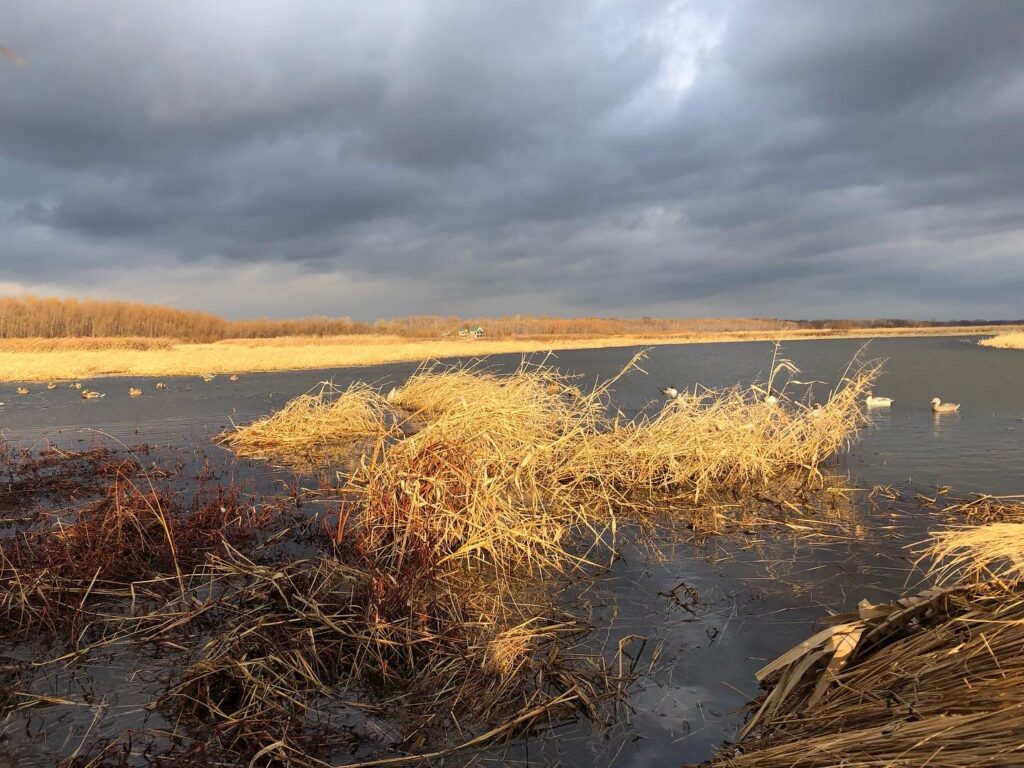The first days of the waterfowl season are always special. In some ways, a dry run for the weeks ahead. And even with time spent on pre-season preparations, there’s nothing like real-time, real-place activities to expose the routine and one’s memory.
Inspect the boats. Get ‘em in the in the water. Reacquaint oneself with the push pole, the camo arrangement, and other gear. Take inventory – did I bring all the necessary accoutrements? Coffee, snacks, lunch, headlamp, gun, wading stick, shotgun shells, decoys…yep. I think I’m ready. The integrity of the waders will be determined as we go. Let the season begin!
At 5:00 a.m. the first sounds of the day can be heard. Footsteps outside the shack, a low muffled acknowledgement between groggy hunters. I turn on a small light and start moving about. My wife slips into the first layer of her hunting clothes. I worship the coffee maker and glance at my phone for news headlines and changes to the weather forecast.
At 5:30 I hear a truck arrive. More talking outside and a UTV starts. We eat a little breakfast, add provisions to our boat bags, and head out the door to greet others and get the morning update. A couple of the crew stand outside gazing at the sky watching for a stray meteor, waders and jackets on, gear loaded in the side-by-side. Discussion includes a reassessment of the weather, wind direction, and a strategy for the day.
Headlights a mile down the gravel road remind us we are not the only early risers in the county. Farmers arrive to get beans and corn out of their fields. Rain is in the extended forecast, so the going is good right now.
A final gulp of coffee and the group disperses. I grab my gear and head east down the levee, a 300-hundred-yard walk to my layout boat. I will hunt solo today. My wife heads out in the UTV with another club member to hunt out of a blind south of where I’ll setup.
As I push off into the darkness and head down a shallow cut into the marsh, a few ducks can be heard, a quack or two here and there. There’s nothing like the stealthy approach of a pole boat in the marsh; a north Missouri gondola ride. Reflections off the water, stars, ripples, dark shadows of ducks rising, a faint horizon in the distance.
My headlamp illuminates a pair of greenish eyes to my right watching me from low within the millet. Another pair appear on my left at the edge of the cordgrass, and another pair a few yards ahead.
“I see you,” I call out as the eyes disappear into the marsh.
The reflective silhouette of an obstacle across my watery path comes into view. As I get out of the boat to pull over it, I imagine a Stephen King scenario involving mysterious green-eyed marsh critters.
A couple more dams of mud and vegetation slow me down before reaching the open water of the pool where I will hunt. A few days from now the damn dam-building culprit would reveal himself. An adult beaver would escort me a couple feet off the bow, giving me a tail slap salute as I cruise past him.
I arrive at my hunting spot and turn off the headlamp taking in the view of the faint eastern morning light, assessing changes to the marsh from the previous year, and how I will set up for the wind, or lack thereof. I hear the faint distant sounds of plastic decoys being set by my partners to the south, and in 20 minutes, my decoys are out and I’m in the boat ready to watch the show. At 7:00 a.m. the guns of autumn can be heard throughout the area – 2022 duck season has officially arrived.
Opening day came and went with mixed results. Getting ducks in the decoys was tough and shooting slow, but the evening show as birds left daytime loafing areas for the nighttime roost told us many thousands of birds were here and future opportunities would be promising. Teal and pintails dominated, mallards, gadwall, widgeon and others mixed in. The first week or two can always be a mixed bag, and this year was true to form. Marsh food was exceptional, water was low but slowly rising, and the temps were unseasonably warm. The key to success would be location, timing, and a little luck. For me, as long as I can see ducks flying, there’s hope. As long as there’s hope, I’m in the boat. And while hunting was a little slow, a nice late-morning nap in the warmth of the sun was enjoyable.
During week two things would pick up a bit and our anticipation increased as the weather forecast indicated a classic Armistice Day cold front with winter storms for the Dakotas. The bad news – the cold front was predicted to settle over Missouri for an extended period. The marsh would be frozen solid too soon for too long, and as the season is just getting started, it may also be simultaneously coming to an end.
The Armistice Day hunt would be good. A migration day for sure, many species of birds would come through, flocks responded to calling, and a few speckle belly geese would start trickling in. Snow geese were still lingering somewhere in the northern latitudes. A stiff northwest wind introduced us to winter and reintroduced us to the joys of poling a boat stacked with decoys headfirst into the wind. And at the end of the day, tired happy hunters would recount their hunt as they prepared duck meat for future meals with family and friends.
As I write this, the deep freeze is settling in over the marsh. Hopefully the late November early December temperatures will elevate, and we can get back to the serious business of duck hunting. Until then, I’ll swap camo for hunter orange for a time and keep the wood stove going for afternoon naps.
Waidmannsheil!
by Dan Zekor




